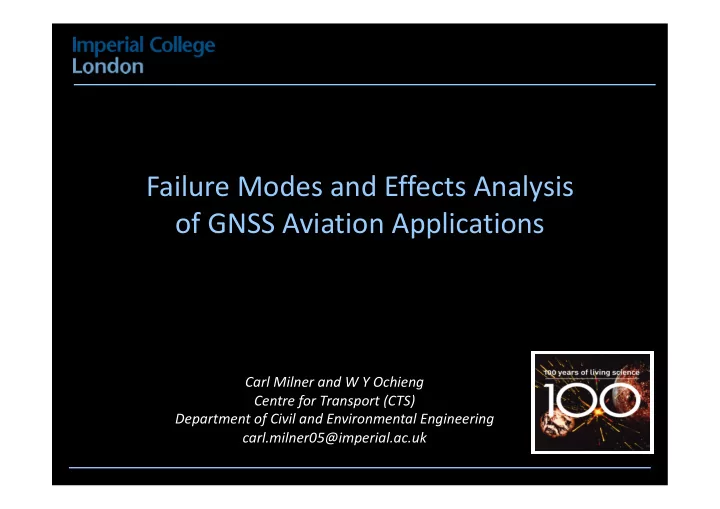

Failure Modes and Effects Analysis of GNSS Aviation Applications Carl Milner and W Y Ochieng Centre for Transport (CTS) Department of Civil and Environmental Engineering carl.milner05@imperial.ac.uk
Outline Definition and relevance of integrity Challenges FMEA Methodology and Structure Failure Characterisation Conventional Proposed concept Step Ramp Failure Impact on Integrity Risk Weighted‐RAIM Integration Numerical Errors VPL Results Bias‐RAIM Conclusions carl.milner05@imperial.ac.uk
Definition and Relevance of Failure Integrity relates to safety criticality failure alerting function with a prescribed risk The system is required to deliver a warning ( alert ) when the user position error exceeds an allowable level ( alert limit ) A warning must be issued within a given period of time ( time-to-alert ) and with a given probability ( integrity risk ) carl.milner05@imperial.ac.uk
Challenges of Integrity Integrity risk is the product of the probability of failure and missed alert Integrity monitoring is essential to meet the requirements (RAIM ‐ Receiver Autonomous Integrity Monitoring) The application of failure probabilities may not always provide a strong link between reality and algorithm design / performance requirements The computation of missed alert probabilities may also incorporate conservative modelling assumptions Solution: a state‐of‐the‐art Failure Modes and Effects Analysis (FMEA) carl.milner05@imperial.ac.uk
FMEA Methodology and Structure carl.milner05@imperial.ac.uk
Failure Characterisation Conventional (stand‐alone) Binary function (GPS SPS Performance Standard) No information for failures < 30m Ambiguity in size of bias beyond 30m Defined per time period (per year per hour) Performance requirements derivation Failure rate factored to operation time period (per hour) e.g. Integrity Risk 10 ‐7 = 10 ‐4 (failure rate) × 10 ‐3 (missed alert) Algorithms apply quantities on an epoch‐by‐epoch basis carl.milner05@imperial.ac.uk
Failure Characterisation SBAS WAAS Integrity Threat Model Greater detail for ramp errors Step errors defined from 3.6m yet definition is still vague One step towards a more Error Magnitude Probability detailed model is taken STEP >3.6m 10 ‐4 /h RAMP 0.001m/s to 0.05m/s 10 ‐6 /h Failures are not defined in an instantaneous manner nor RAMP 0.05m/s to 0.25m/s 10 ‐6 /h utilise exposure time RAMP 0.25m/s to 0.75m/s 10 ‐6 /h RAMP 0.75m/s to 2.5m/s 3.5 × 10 ‐6 /h Proof that a drive towards a more sophisticated model RAMP 2.5m/s to 5m/s 4.1 × 10 ‐6 /h can be achieved in a certified RAMP 0.001m/s + 10 ‐4 / h application carl.milner05@imperial.ac.uk
Failure Characterisation Proposed Concept Failure model is a detailed function of bias Failure model is defined on an instantaneous epoch‐by‐epoch basis carl.milner05@imperial.ac.uk
Failure Characterisation Proposed Concept Step Magnitude remains constant over time Step errors over a range are processed identically Area under the graph is normalised: carl.milner05@imperial.ac.uk
Failure Characterisation Proposed Concept Ramp Must consider the time the failure mode lies between b 1 and b 2 Use a linear bound on the no detection probability after t min_exp Reasonable to assume remaining failure probability decreases exponentially carl.milner05@imperial.ac.uk
Failure Characterisation Conclusions P(30<B) = 9.6e‐06 / sample (New) P(30<B) = 1.25e‐5 / hour (Trad.) Includes empirical orbit modelling failure mode Natural model for a sample based assessment of integrity risk Number of independent samples per hour Important consideration for Galileo – openness of information carl.milner05@imperial.ac.uk
Failure Impact on Integrity Weighted RAIM Let us consider the workings of an on‐board integrity monitoring The minimal detectable bias is projected to the position domain Unweighted RAIM – no correlation between stochastic elements of Weighting the position solution causes correlation the test statistic and position error Approximate by 2D Gaussian – Use Schur Matrix to define conditional pdf carl.milner05@imperial.ac.uk
Failure Impact on Integrity Numerical Errors 2D Gaussian Approximation Numerical Errors must be accounted Gaussian approximation of test statistic domain from non‐central chi‐square distribution Analytic approximations to Gaussian curves Numerical Integration Errors Integration procedure truncation error (E) Functional round off error Included either at the point of computation or as global errors Integration procedure therefore both conservative and worst‐case carl.milner05@imperial.ac.uk
Failure Impact on Integrity VPL Results APVI Availability (%) Aerodrome Conventional New Gatwick 73 93 JFK 64 83 Sydney 58 89 5 minute samples APVI Availability improved by ~30% Processing time of < 2 seconds Validation procedure: VPLs compared to ideal Monte Carlo carl.milner05@imperial.ac.uk
Failure Impact on Integrity Bias ‐ RAIM APVI Availability (%) Aerodrome Conventional New WRAIM Bias RAIM Gatwick 73 93 94 JFK 64 83 90 Sydney 58 89 91 Unsurprisingly lower VPL in most cases due to lack of ambiguity Must be integrated over all biases due to the way model is defined Leads to problems at low biases < 30m in some cases Further tests required carl.milner05@imperial.ac.uk
Conclusions Challenge exists to model integrity risk realistically through capturing accurately failures and their probabilities evaluating the failures’ impact on the integrity monitoring functions Novel ‘Total Failure Model’ concept shows there exists a means to link failure modelling to performance requirements and RAIM Accelerated integration of weighted‐RAIM integrity risk is able to improve APVI availability considerably Bias‐RAIM is an example of how a more sophisticated failure model may be used Extended Concept: Assessing the augmented system would require a more sophisticated model of ionospheric error probabilities carl.milner05@imperial.ac.uk
Thank you carl.milner05@imperial.ac.uk w.ochieng@imperial.ac.uk www.imperial.ac.uk/cts www.geomatics.cv.imperial.ac.uk carl.milner05@imperial.ac.uk
Recommend
More recommend